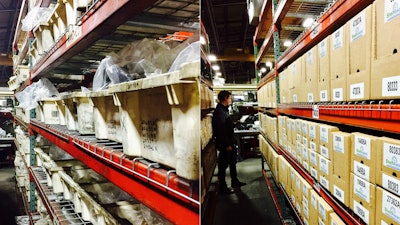
It started as a challenge in a sales meeting, a challenge to reinvent the tired Vendor Managed Inventory (VMI) systems that industrial distribution has been utilizing for decades.
O-ring Sales & Service is a 35-year-old distributor of seals and gaskets that has experienced a companywide technological rebirth over the last five years. We recognized that the technology that had revolutionized the way we did business could and should be implemented into a robust system for our customers. So, we took the challenge and began to study the problem and the current solutions in an attempt to reinvent inventory management (view photos in gallery).
We see the problems first hand – many original equipment manufacturers (OEMs) struggle to effectively manage their purchased inventory. The challenges are numerous:
- Tracking physical on-hand values
- Maintaining an organized and space-efficient stock
- Keeping inventory fresh and lean
- Making sure they don’t run out of parts.
The dreaded stock-out, the cardinal sin of supply chain managers, holding up a multimillion dollar build because the OEM doesn’t have stock on a penny part. Purchasing agents spend considerable time managing hundreds, if not thousands, of parts spread across a wide supply base, each with unique lead times, minimum requirements and service levels. All of these problems present constant delays in the production of finished goods.
Historically, these challenges have been outsourced with the burden put on the vendors utilizing a vendor-managed inventory (VMI) system. There are two predominant methods of VMI in industrial distribution today.
The first method has not changed in decades, and involves the vendor regularly sending employees on-site to monitor bins and record replenishment needs. The expense to the vendor for this type of system is considerable, leaving them in a difficult position to be price competitive. Vendors typically build the increased labor, travel and other overhead costs into the price of the items sold.
The second common method of VMI is a slight upgrade over traditional systems. With the use of technology add-ons, like barcode scanners or weigh nodes and additional processes, the vendor attempts to push the daily inventory tracking back on the OEM. This greatly reduces the costs to the vendor, but requires a big commitment from the OEM’s staff.
The benefits of the tech add-ons, which are intended to add efficiencies, are quickly outweighed by the many shortcomings of the now complicated system; leaving the OEM struggling to get factory line workers on board with these complex rules, dooming the system from day one.
Our task was clear: create an inventory tracking system that could be run remotely without complicated processes or rules. Simple enough, right?
We started by looking to a growing technological revolution, the Internet of Things (IoT), a development in which regular objects have network connectivity. This concept was a familiar one; we had already embraced the IoT for our own operation, developing a smart counting scale and mobile app to further automate our shipping process.
IoT presented exciting new opportunities in inventory management using state-of-the-art technology to make inventory intelligent. In our case the intelligent inventory is consumable o-rings and a wide range of other sealing products such as engineered plastics and custom molded rubber.
That was the key concept, making the consumable inventory smart, allowing us to remotely collect endless data points that drive automated analytics for each inventory item.
This landed us on another key concept that builds the foundation for intelligent inventory management, big data. Another growing tech trend that has started to change our industrial marketplace, big data is the collection of extremely large data sets that can be analyzed computationally to reveal patterns, trends, and associations.
As we collect big data on each inventory item we apply a host of inventory analytics that have been developed in-house over the last several years to automate the replenishment of our own supply chain.
After more than two years of development, we launched our patent pending ShelfAware inventory management system in 2016. ShelfAware is built upon a foundation of IoT, big data, and automated analytics, making inventory intelligent. This allows OEMs of any size, from any industry, located anywhere in the world, to leverage purchased inventory.
ShelfAware is a flexible inventory management system that allows for new features to be easily added, such as the new ShelfAware App, and installed on the OEM’s factory work terminals and PCs. With this new app, OEM gains full supply chain visibility to any inventory item.
The app allows users to not only see what is on their shelf, but also what quantity is on our shelf and what quantity is in our factory pipeline. This unprecedented supply chain visibility takes the guess work out of sales and operations planning (SOP).
The data collected at the item level is a key metric for every aspect of an OEM’s SOP activities, including sales and marketing, production planning, operations, purchasing, and finance.
ShelfAware is a concept that started as a challenge in a sales meeting and is now the beginning to our company’s ongoing quest for the perfect inventory system.
It is also a fundamental element of Industry 4.0, a movement towards automation and data exchange in manufacturing technologies that creates smart factories.
Looking back on the last several years of manufacturing stagnation in the U.S., it is clear that we must adapt or die in this new global marketplace. Our advantage in the U.S. is technology.
For the past few decades, we have been concentrating on the performance of our products. Now, with Industry 4.0, we need to concentrate on the performance of our factories. It’s time to work on your business, not in the business. Take a step back to reevaluate your company’s SOP process. It is time to adopt business technologies that affect how you do business, how you plan, and how you strategize.
Often overlooked business practice improvers, like a paperless office, cloud computing, and decision level analytics, can save companies huge amounts of overhead expense, providing a big impact to their bottom line.
A smart factory starts with intelligent inventory that allows us to leverage data to automate all aspects of every SOP process. This creates broad efficiencies that are felt from the front office to the dock door.






















